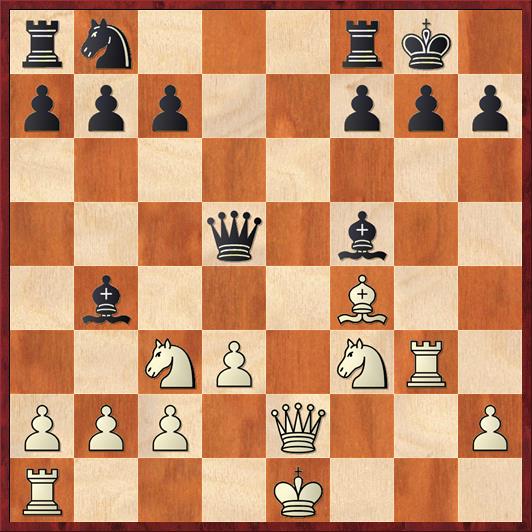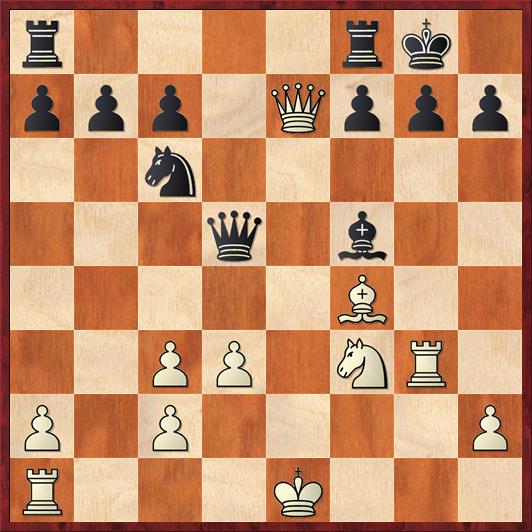You’re White in this position. What would you do?
 Position after 12. … Bf5. White to move.
Position after 12. … Bf5. White to move.
FEN:rn3rk1/ppp2ppp/8/3q1b2/1b3B2/2NP1NR1/PPP1Q2P/R3K3 w Q – 0 13
This wasn’t an actual game, but if I were playing White I would first look at 13. Bxc7, winning back my pawn. I would realize that doesn’t work because of 13. … Na6, both threatening the bishop and threatening a pin on the e-file. Then I would start looking at 13. O-O-O, offering a second pawn sacrifice for some unclear attacking chances on the kingside. If this were a blitz game, that’s probably what I would play.
The one move I think I would never even look at (certainly not in blitz) is 13. Qe7! That’s the “computer move” that Rybka comes up with.
Why do I have a blind spot for this move? I think it’s because I’m just not accustomed to looking at moves that simply put my queen en prise. The queen seems to be on a suicide mission on e7. But in fact, it’s completely safe. It’s just a simple deflection sacrifice; if Black takes with 13. … Bxe7, then he unpins the knight and I can play 14. Nxd5 Bd8 15. Bxc7 winning back the pawn with, I think, a comfortable advantage for White.
The queen move nicely solves White’s problems in other ways, too. If 13. … Qa5 then I have time for 14. Qxc7, which wins back the pawn and defends c3 and gains a tempo with the threat (if it is a threat) to exchange queens. At least White is out of trouble here, though probably not better.
Likewise if 13. … Qe6+ 14. Qxe6 Bxe6? would be met by 15. Bh6. So Black is forced into the inferior 14. … fe, and again 15. Bxc7 wins the pawn back with a better position for White because of Black’s fractured pawn formation.
The really cool thing is what happens after the seemingly logical 13. … Bxc3+ 14. bc Nc6, attacking the queen and getting ready to bring a rook to the e-file. How does White continue?
 Position after 14. … Nc6. White to move.
Position after 14. … Nc6. White to move.
FEN: r4rk1/ppp1Qppp/2n5/3q1b2/5B2/2PP1NR1/P1P4P/R3K3 w Q – 0 15
Hint 1: Think aggressively!
Hint 2: What would Wei Yi do in this position?
If you remember Wei Yi’s “immortal game” against Bruzon from earlier this year, you’ll probably have no trouble spotting the rook sacrifice 15. Rxg7+!! Kxg7. Then, because a rook is hardly enough to give away, you’ll follow it with a piece sacrifice 16. Bh6+! Capturing leads to mate in one, so Black has to give up his queen 16. … Kg8 17. Qg5+ Bg6 18. Qxd5, and it’s an easy win for White.
Well, that was fun! A (pseudo-) queen sac, a rook sac, and a bishop sac, all in the space of four moves.
Postscript: If you’re wondering where this position came from, it’s not an actual game. I was fiddling around last night with the idea or question of whether White has an alternate route into the King’s Bishop’s Gambit with 1. e4 e5 2. Bc4 Nf6 3. f4 (instead of 2. f4 first and then 3. Bc4). At first I thought this was a terrible idea because Black can take with the knight instead: 3. … Nxe4. I played around with the idea of 4. Qh5?, which does win back the pawn, but I had to admit that after 4. … d5 5. Qxe5+ Be6 Black is having all the fun. He is already ahead in development and is going to gain some more tempi by kicking around White’s queen.
Out of curiosity, I put the position on Rybka this morning and was surprised to see that it didn’t think White’s position was all that bad after 3. … Nxe4. It gives Black an advantage of 0.3 to 0.4 pawns, but that’s not unusual. The computer often gives Black a 0.3-pawn advantage in the King’s Gambit, but that’s because White is a pawn down with some compensation.
Instead of 4. Qh5?, Rybka says that White should play 4. d3! Then a few moves of “best play for both sides” went as follows: 4. … Qh4+ 5. g3 Nxg3 6. Nf3! (a known trick in the Vienna, so it’s not surprising to see it here) 6. … Qh5 7. Rg1 d5! (if not for this resource, the position would just be winning for White) 8. Bxd5 ef 9. Nc3 Bb4 10. Bxf4 Qxd5 11. Rxg3 O-O 12. Qe2 Bf5?! and we arrive at the first diagrammed position. The move 12. … Bd7 would probably have been safer, but at least initially 12. … Bf5 was Rybka’s top choice.
My conclusion is that 1. e4 e5 2. Bc4 Nf6 3. f4 is definitely good enough for blitz, and maybe even good enough for a tournament game.



{ 12 comments… read them below or add one }
Dana’s Chesslecture on the King’s Bishop Gambit had a profound effect on me and I have made it my favorite opening. Just last night on Playchess.com I won a KBG with almost the identical structure to Dana’s lecture – the black queen took my king’s rook but got trapped on the H file while I chased his king over to the A file and mated it. Without Dana’s lecture, I would never have even considered such a line of play – losing a rook and wrecking my pawn structure.
Dana, it would be so great if you would publish a set of your KBG games. Also, wouldn’t it be great if Dana created an audio blog similar to ChessLecture. What a pleasure that would be!
Finally, here is a lecture format that has never been used but that would break new ground. Two players, say Dana and Mike Splain, play a game remotely so that they are not in the same room. Now, as each player makes a move, he verbally describes what he is thinking. The game with audio annotations is recorded and edited to cut out the minutes of silent calculation, leaving a lively and informative record of the game. It would give the viewer an unprecedented perspective on the mental processes of the struggle.
Paul
Thanks, Paul! I appreciate your comment and your suggestions. The thing that has stopped me from creating an audio blog or podcast is the fact that I’d need to invest in hardware (a microphone). Also, chess lectures are so much better with video that I would need to figure out how to do that. The great thing about ChessLecture was that they did all those things for me — they recorded the audio and video over Skype and did all the polishing so that I only needed to worry about the lecture itself.
Also, if I were to home record my own chess videos, I would essentially be doing ChessLectures all over again — and not getting paid for them! I admit that the pay for ChessLectures was a pittance, but over time it added up to a fairly decent pittance. I don’t get paid for my blog, but the time investment for it is considerably less than for my ChessLectures, so I’m willing to do it.
I like your “audio annotations” idea. I did record a somewhat similar ChessLecture once: Josh Friedel and I both talked about a game that we had played, with him telling his thoughts and me telling mine. It was fun but it ended up being a bit disorganized. Ideally, lessons should be planned out in advance but in this case neither of us knew what the other would say. To make things worse, my connection cut out for about five minutes in the middle of the lecture (this was pre-Skype) and so Josh was talking and talking with no comment from me — I’m sure that the listeners must have wondered where I went! If you haven’t seen that lecture and you’re curious, it was called “Dueling Masters: Crouching Ruy, Hidden Bird.”
By the way, I would love to see your KBG game on playchess.com.
Unfortunately it was a 20 minute coffeehouse brawl and I didn’t save it.
Hi Paul,
British Radio (BBC?) had a regular chess program back around 1960. They frequently did what you suggested, with the two players playing in different rooms. only the radio show had two masters in each room consulting against two other masters. I’ve seen transcripts of a couple of those shows. They were fun to read.
“Yes, that works if they take the pawn but what if they play Bishop to knight five instead?”
“Then we play Rook to Queen five and ‘Bob’s your uncle.’ ”
“Sounds good. So it’s pawn to knight six then.”
Qe7 is a crazypants move! If you gave 10 masters , say, a couple minutes each to find White’s best move in that position, I’d bet on 0 coming up with Qe7. My first reaction when I saw “13.Qe7!” was that I had skipped to the wrong paragraph!
P.S. Dana I want to play that move order! Here’s a fun game I found in the main line: http://chesstempo.com/gamedb/game/2033367/ply/6
Thanks for cluing me in to this game! As good or better than anything you would find in the nineteenth century — probably better, because Anand defended better.
The move order 1. e4 e5 2. Bc4 Nf6 3. f4 is actually really old; MCO 11 (my go-to opening reference even though it’s a fossil too) attributes it to Greco. Interestingly, the main continuation in MCO 11 is 3. … Nxe4 4. d3 Nd6 5. Bb3 Nc6, which Rybka considers to be equal. Looks to me as if there’s plenty of play in this position. It would be nice to know if there is any more recent theory on it.
Sorry, you would lose that bet. I found 1. Qe7 in about 60 seconds. It was my third candidate move. I looked at 1. 0-0-0 and 1. Rg7+ first. In a game I would probably have played 1. 0-0-0
It took me far longer to see the right continuation after 1. Qe7 Bc3 2. bc Nf6. I didn’t see the mate in one after the rook and bishop sacs.
Mike
Haha. The only player I asked so far also considered it!
I’m so sad that I’ll never know whether I would have found 13. Qe7 or not. Anyway, Mike’s comment is also worth noting. There are two things that are not obvious about 13. Qe7 — first, that it’s feasible at all, and second, that it’s useful. Obviously it threatens 14. Qxb4 and 14. Qxc7, but the extra threat of 14. Rxg7+ is the real kicker.
Anyway, a truly cool “crazypants” move (I like that word! Where did it come from?) and definitely mind-expanding for me.
The point about such an interactive audio game is that it is a zero-sum game with only one winner. Both players are annotating their moves until suddenly one realizes that he is losing. Then we hear the loser groan and describe how he is going to chase a draw while the winner smugly explains how he is going to crush his opponent. As a result, the game becomes a human drama with real people bleeding on the chess board. It might be nice to have a third or even fourth person kibbitz out of the player’s earshot in real time “What a schmuck! I can’t believe he made that move!” as the player explains his brilliant idea.